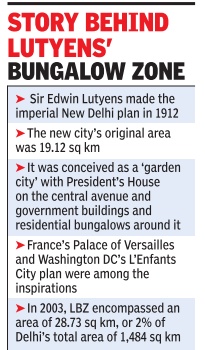Delhi: Lutyens
This is a collection of articles archived for the excellence of their content. |
Lutyens' vision

The Times of India, Aug 29 2015
Lutyens planned Delhi with a garden city in mind
When Sir Edwin Lutyens sat down at his drawing board to design Imperial New Delhi just over 100 years ago, he was inspired by the ideas of the Garden City Movement started by another English architect, Ebenezer Howard, in the late-1800s. The movement, an urban planning concept, saw a city as a group of planned, self-contained communities surrounded by green belts “containing proportionate areas of residence, industry and agriculture“. So Lutyens' Delhi, also known as the “Eighth City of Delhi“, stood out from the start with wide tree-lined avenues, large plots and spacious bungalows set in them. The President's House was set on a central avenue surrounded by government buildings and residential bungalows.
Lutyens unveiled his plan in 1912 and the new city , occupying 19.12 sq km, was built over 20 years. Located to the south of Shahjahanabad, it quickly became the seat of the rich and influential.
“The city was laid out in a grand manner and is an excellent example of a fine blend of classical and modern town planning. It lay on an east-west axis, starting at Rashtrapati Bhavan atop Raisina Hill and terminating at the India Gate `C' hexagon, said an official.
Even Delhi's hot and dry summers were factored into the design.“Rashtrapati Bhavan, North Block and South Block, large bungalow plots and other government buildings knit together carefully by a web of wide shady avenues lend to the city a grand order, symmetry and unique aesthetic character, says a description of Lutyens' Bungalow Zone (LBZ).
Besides the Garden City Movement, France's Palace of Versailles and Washington DC's L'Enfants City plan also provided Lutyens with inspiration. The hundreds of bungalows were designed by well-known British architects like WH Nicholls, CG Blomfield, Walter Sykes George and Arthur Gordon Shoosmith.
Experts say LBZ is unique and the only `new town' in the world inspired by the (much-modified) Garden City Movement. But the urban development ministry says LBZ should not be compared to Howard's `garden city' because it was envisaged as a suburb to a central city, while LBZ is the heart of New Delhi.